Well, at least things are going well along the Neman river  Hopefully in the East Japan's convoys are getting put on blast - just about the only useful thing the Allied AI is guaranteed to try to do lol.
Hopefully in the East Japan's convoys are getting put on blast - just about the only useful thing the Allied AI is guaranteed to try to do lol.
Invincible and Legendary - The history of the Soviet Union during the Great Patriottic War
- Thread starter sebas379
- Start date
-
We have updated our Community Code of Conduct. Please read through the new rules for the forum that are an integral part of Paradox Interactive’s User Agreement.
You are using an out of date browser. It may not display this or other websites correctly.
You should upgrade or use an alternative browser.
You should upgrade or use an alternative browser.
Is the USA still just doing nothing? Is this some kind of plot to allow the two totalitarian states to kill each other? Because it will fail if badly for the Allies if Germany wins. Keep fighting the good fight!
Well, at least things are going well along the Neman riverHopefully in the East Japan's convoys are getting put on blast - just about the only useful thing the Allied AI is guaranteed to try to do lol.
Theres too high a concentration of Axis divisions behind the Memel/Neman river for comfort, its a dicey situation. My ancient subs are doing what they can and do sink the occasional convoy, but that is never going to decide the war there. We need either a major ground operation to drive them back, or the US/Royal Navies to cripple Japan's fleet for good.
Is the USA still just doing nothing? Is this some kind of plot to allow the two totalitarian states to kill each other? Because it will fail if badly for the Allies if Germany wins. Keep fighting the good fight!
Their fleet does patrol a bit here and there, but not really. They'r playing historically I guess, let the Axis and Comintern wear each other down, then swoop in and claim all the glory
- 1
I absolutely adore Soviet AAR's when they're well done, and this one is fun and engaging with just the right amount of failure to keep the outcome in doubt, and the mistakes you make are good for the narrative. You're doing good work.
Last edited:
I absolutely adore Soviet AAR's when they're well done, and this one is fun and engaging with just the right amount of failure to keep the outcome in doubt, and the mistakes you make are good for the narrative, and . You're doing good work.
Thank you! I assure you, the mistakes are mostly not on purpose
edit: speaking of fun: After a few hectic weeks of work I'm trying to get the next chapter done this weekend. Until then, we go live to a German army base near Letyshin, from which we receive alarming reports of massing German forces.
Last edited:
Invincible and Legendary
The History of the Soviet Union during the Great Patriottic War
June 1942 Part 2
The History of the Soviet Union during the Great Patriottic War
June 1942 Part 2
The German Wehrmacht continues its ferocious offensive action across primarily the northern part of the front. The Baltic States and the Memel river are the sights of particularly bloody engagements throughout June 1942, though of course the war rages on around the globe. Great cities of Eastern Europe are pulverised between the forces of the Soviet Union and Germany.

The city of Memel, June 1942
Foreign Affairs
The war in Southeast-Asia rages on as British and Japanese forces continue to clash in southern Malaya. The Imperial Japanese Army is hell-bent on capturing the crown jewel of the east, the great coastal fortress city of Singapore. They face determined resistance by the British garrion however, who contest every meter of Malayan soil with the help of troops from the Army of India. Though battered, Fortress Singapore still stands strong.
Finnish Front
The minor action that began around Kirkenes on the 17th continues for 3 days until local Soviet infantry divisions are forced to abandon their attempts at keeping the 70.000 strong German garrison in the city pinned in place. As other Soviet infantry is advancing west of the city, Soviet High Command hopes to deal a blow to the German army in the freezing theatre of northern Finland. Soviet infantry advanced slowly through the snow, reaching the coast east of Kirkenes at dawn on the 23rd, completing the encirlement of the German garrison army in Kirkenes. German forces in Norway immediatly started relief attempts and the Soviet garrison in Petsamo began drawing the attention of the German garrison army, hoping to pin them in place in what would be known as the Battle of Garrisons.
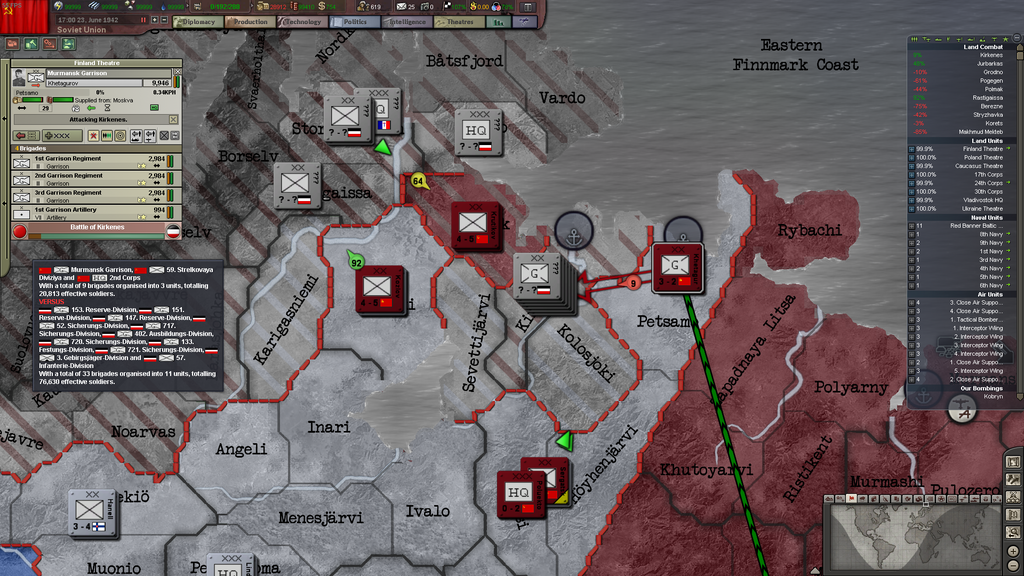
The Soviet encirclement of Kirkenes lasts no more than 3 days until the Germans break through the blockade of the 35th and 66th red rifle divisions. The woefully outnumbered and outgunned Soviet infantry divisions sell their skin dearly, but there were simply not enough Soviet forces in the area to destroy the massed German garrisons. Of 93.700 surrounded Germans, 92.000 make it back to their lines in Norway, whilst the 20.000 Soviets in their way suffer 2200 casualties before retreating.
The conclusion of this battle is that whilst both sides have sufficient forces in place to prevent an enemy breakthrough in the area, neither side has a sufficient advantage in either quantity or quality to force a decisive victory. Another Soviet attempt to take the city ends in disaster on the 26th as Soviet forces lose 2000 men in a vain attempt to prevent a German withdrawal from the city, against 500 German losses. The blocking divisions west of the city are exhausted and Soviet forces east of it stand no chance as they have to attack across a river into the teeth of entrenched German mountaineer divisions, 77.000 strong.
Baltic Front
Heavy fighting continues in the ruins of Memel as the Wehrmacht throws a fresh infantry corps into the fray, desperate to drive the Red Army off of German soil. Despite around-the-clock Soviet air raids and shore bombardment by the Red Banner Baltic Fleet, the Red Army is forced to one again withdraw from Memel on the 20th of June after a ferocious battle. However their efforts have not been in vain as the German army paid a very steep price for the ruined remnants of the once proud city.
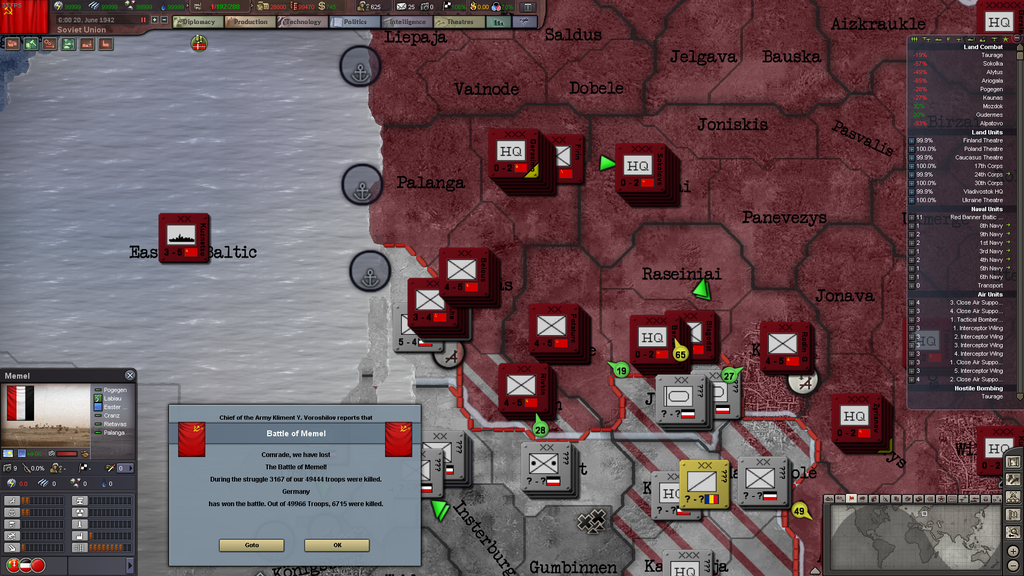
As the Red Army pulls back from Memel, a smaller yet equally fierce German attack against Taurage is beaten off with over a thousand German casualties to 350 Soviet. The following day the German offensive in southern Lithuania is brought to a halt as their attacks on Kaunas and Ariogala are fought to a standstilll. Their attacks between Kaunas and Bialystok are much more succesfull however, and the Wehrmacht breaches the Red Army Memel Defence Line.
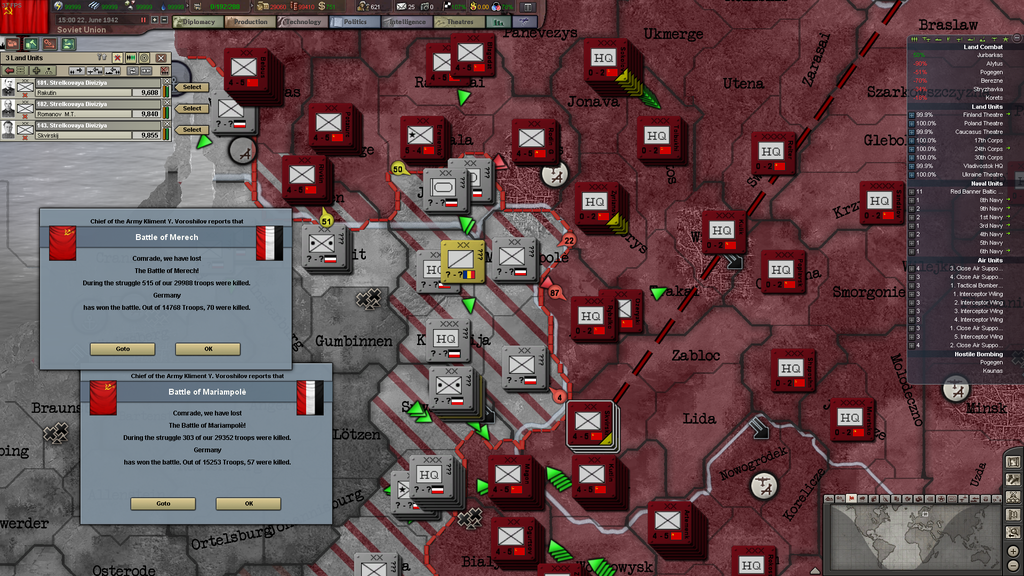
German forces press forward and manage to establish a beachhead east of the Memel river in Alytus the following day. As it appears more and more German forces are massing south of East-Prussia, the Red Army moves some scarce reserves from Lithuania south to the sector between Bialystok and Wilno. 2 Soviet infantry divisions here broke after losing 1500 men total, double the German losses who had heavy dive bomber support available.
The Red Army is once again determined to reestablish its defensive line on the Memel and launches a counterattack against the most recent German bridgehead in Jurbarkas before the enemy can entrench. Red Guard divisions lead the assault against German armour and infantry, suffering heavy casualties of up to 30% in some units in the ruined forests surrounding the town. Despite these losses, the Germans are forced back across the Memel once again on the 23rd. Unfortunatly their victory is short-lived as other German forces break through the 6th Tank Division defending Pogegen, west of Jurbarkas, the following day. 2000 Soviet tankers and over 3000 German forces perish in the bloodbath, but as Soviet infantry reinforcements arrive too late the defenders of the town are forced to fall back, harrassed by Stukas all the way.
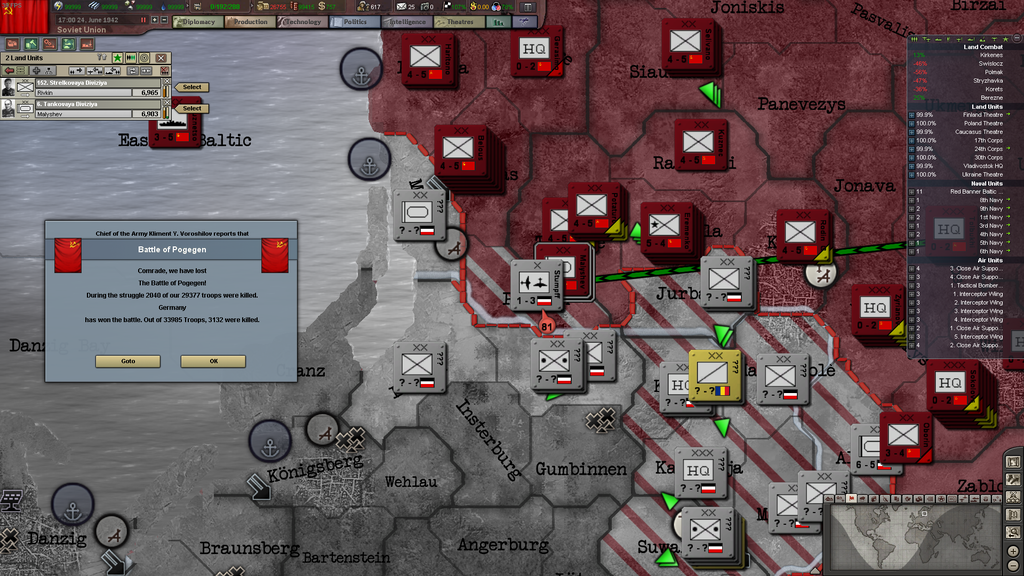
The German bridgehead east of the Memel River in Alytus is broken once again in the evening of the 28th when a 70.000 strong force of Red Army infantry force back a single 8.000 German heavy tank division after a brief battle. But more important was the latest battle of Taurage and Jurbarkas on the 29th, where despite taking 2500 casualties to only 900 Soviet, the Wehrmacht took control of a significant portion of the northern Memel riverbank.
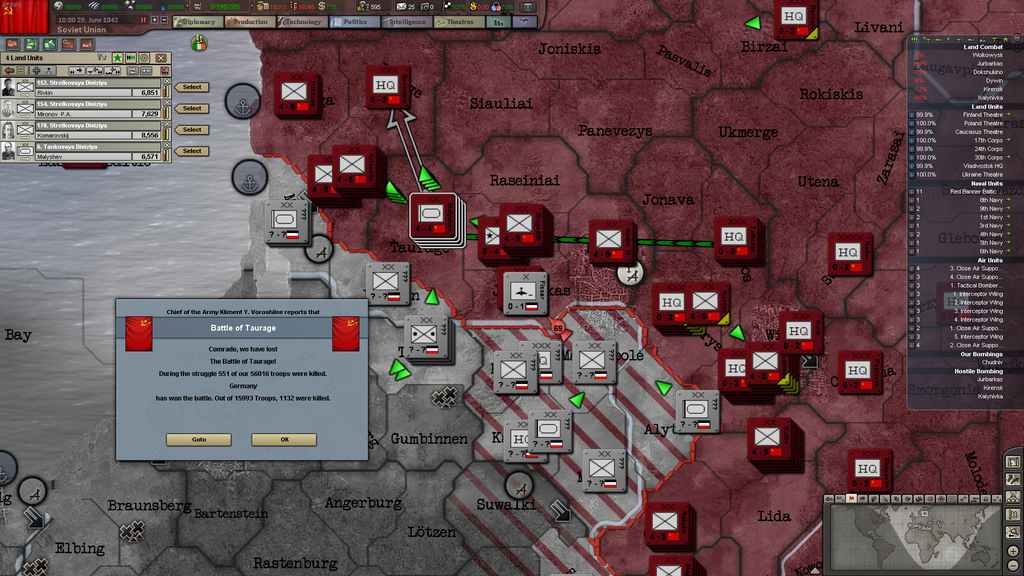
Polish Front
After the Wehrmacht spend the first half of June preparing its forces in central Poland, they once again went on the offensive in the second week of the month, on the 14th. Having battered their heads in vain against the great Soviet fortress city of Bialystok repeatedly, a new attack was launched just north of it against Sokolka. Situated on the strip of navigable land between the fortress city and the Memel river, it was the best location for an attack and the Soviets knew it. One of the toughest formations in the Soviet arsenal, the 5th Heavy Tank Division was deployed here to screen the city's flank and it was there that the German mid-June offensive struck hardest. Another fearsome battle developed here, hallmark of the entire eastern front campaign thus far, as tens of thousands of troops clashed. 75.000 German forces were thrown against the Soviet infantry and heavy armour, which stood their ground and inflicted horrendous losses on the advancing Germans. In spite of air superiority and around-the-clock Stuka dive bomber support, heavy artillery and elite panzer-divisions, the German attack soon got stuck on the teeth of prepared Soviet defensive positions with hidden heavy tanks, anti tank batteries and heavy artillery support. Attack after attack was beaten back with devastating losses and although the Germans managed to fight their way to the last Soviet trenchline around Sokolka, their formations were exhausted and decimated. Thanks in no small part to general Kravchenko's 5th Heavy Tank Division, another humiliating defeat was inflicted on the Germans. Unfortunatly, this victory was short-lived as fresh German forces attacked the exhausted Soviet forces and immediatly forced them to retire behind the Memel river.
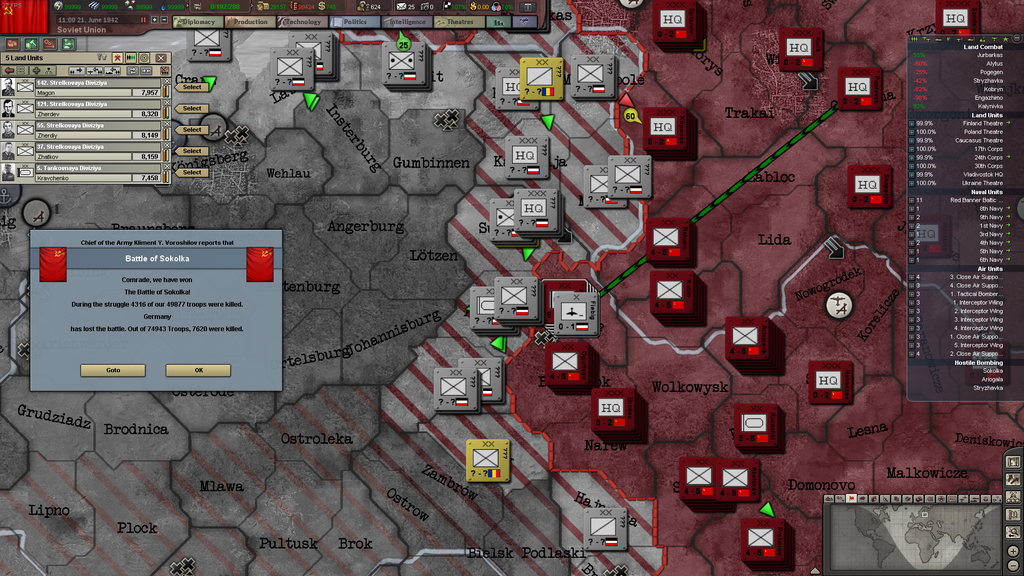
Roughly 100 kilometers south of here at Brest-Litovsk, German, Italian and Hungarian infantry broke out of the city into the town of Kobryn east of it. Soviet infantry lines are easily broken and suffer 1150 casualties, more than double that of the Axis.
As German forces move to occupy the fortress city of Bialystok, German divisions around Brest-Litovsk once again attack the Soviets at Swislocz. The initial defence by 3 infantry divisions is pressed hard and lose control of their forward positions, but before the Germans can take the city reinforcements arrive in the form of the 2nd Red Guard and 32nd Cavalry division, who surprise the Germans in the open and drive their troops back, killing hundreds.
North of Polonne, the city of Korets is taken by the Germans after a short but fierce tank battle between 3 Soviet and 2 German tank divisions. Despite tje advantage in numbers, the Soviets take double the casualties and are forced to withdraw from the town before being broken completely.
A final ferocious German assault against Soviet defences around Swislocz succeeds in breaking through the defensive lines on the 28th, despite taking heavy casualties. 765 Soviet dead are counted amidst the city's ruins as well as close to 2000 German casualties. The same however could not be said about the latest battle of Wolkowysk, where 2 German divisions lost over 1600 men trying to break a Soviet corps, to no effect.
The by now famous town of Dywin, southeast of Brest-Litovsk is once again the site of a Hungarian offensive stopped dead in its tracks. Axis commanders made the grave mistake of believing 14.000 Hungarian light infantrymen capable of breaking a full 50.000 strong Soviet infantry corps with the help of several hundred German Stukas. Axis commanders soon found out they made the biggest mistake since believing the French army would surrender within a month, as 500 Soviet and 2200 Hungarian troops fell in the latest battle of Dywin, with the Red Army retaining full control of the battlefield.
As German forces move to occupy the fortress city of Bialystok, German divisions around Brest-Litovsk once again attack the Soviets at Swislocz. The initial defence by 3 infantry divisions is pressed hard and lose control of their forward positions, but before the Germans can take the city reinforcements arrive in the form of the 2nd Red Guard and 32nd Cavalry division, who surprise the Germans in the open and drive their troops back, killing hundreds.
North of Polonne, the city of Korets is taken by the Germans after a short but fierce tank battle between 3 Soviet and 2 German tank divisions. Despite tje advantage in numbers, the Soviets take double the casualties and are forced to withdraw from the town before being broken completely.
A final ferocious German assault against Soviet defences around Swislocz succeeds in breaking through the defensive lines on the 28th, despite taking heavy casualties. 765 Soviet dead are counted amidst the city's ruins as well as close to 2000 German casualties. The same however could not be said about the latest battle of Wolkowysk, where 2 German divisions lost over 1600 men trying to break a Soviet corps, to no effect.
The by now famous town of Dywin, southeast of Brest-Litovsk is once again the site of a Hungarian offensive stopped dead in its tracks. Axis commanders made the grave mistake of believing 14.000 Hungarian light infantrymen capable of breaking a full 50.000 strong Soviet infantry corps with the help of several hundred German Stukas. Axis commanders soon found out they made the biggest mistake since believing the French army would surrender within a month, as 500 Soviet and 2200 Hungarian troops fell in the latest battle of Dywin, with the Red Army retaining full control of the battlefield.
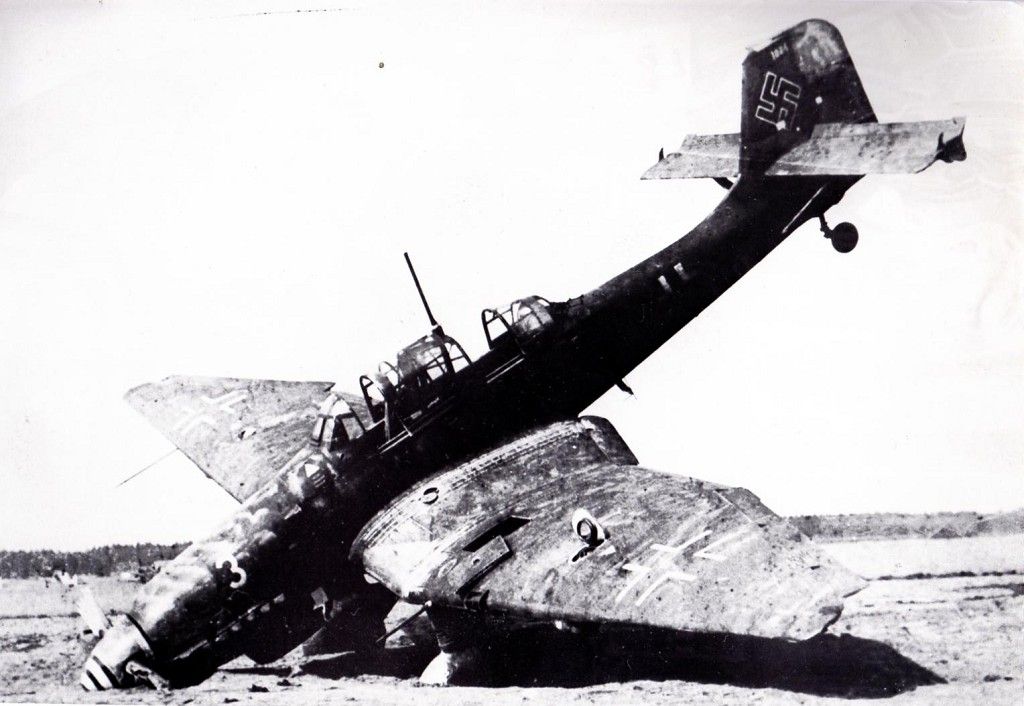
Ukranian Front
Whilst the brunt of the fighting is being done by the Baltic and Polish Front, the Ukranian Front is anything but a quiet sector. A German force of 2 divisions attacks Korets, west of Kyiv in order to probe Soviet defences in the area. These prove to be formidable, including the 3rd 'Bessarabia' cavalry, 10th tank and 203rd motorised divisions, all 3 of them actually armoured formations. The German regiments are caught in a crossfire and suffer heavy losses: 1350 Germans against only 430 Soviet dead.
The sector flares into action once more on the 21st as the Germans attack Berezne and force elements of the Soviet 5th Mechanised Army as well as infantry units to abandon the city, leaving several hundred dead on both sides behind. The Soviet Army continues to put up fierce resistance throughout the next week, resulting in attack and counterattack with heavy use of battalions of T-34 medium tanks. The Soviet counterattack runs into heavy resistance from the get-go but doggedly pushes forward. A single German infantry division attempts to strike in their flank but is driven off with heavy losses by general Panfilov's 10th Tank Division.
The sector flares into action once more on the 21st as the Germans attack Berezne and force elements of the Soviet 5th Mechanised Army as well as infantry units to abandon the city, leaving several hundred dead on both sides behind. The Soviet Army continues to put up fierce resistance throughout the next week, resulting in attack and counterattack with heavy use of battalions of T-34 medium tanks. The Soviet counterattack runs into heavy resistance from the get-go but doggedly pushes forward. A single German infantry division attempts to strike in their flank but is driven off with heavy losses by general Panfilov's 10th Tank Division.

General Panfilov's men counterattack German forces during the battle of Korets

Caucasus Front
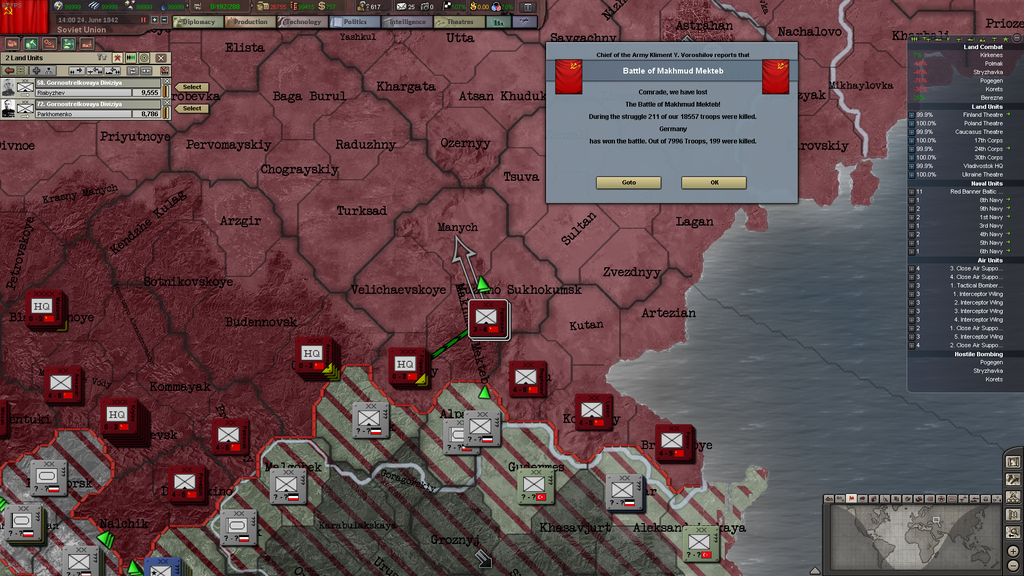
Far Eastern Front
With the central positions of the Soviet Far Eastern Front collapsing, the tough decision to abandon the entire east coast fell to High Command. With the loss of the core of their army in the region still fresh and the Japanese advantage in men obvious, the decision to order their 17th, 30th and 31st Corps into full retreat was an easy one for Soviet High Command. If these divisions do not fall back to Siberia now they are at risk of being surrounded like their comrades north of Vladiwostok, which would be a disaster. Red Army High Command hoped the Lena River northeast of Lake Baikal would give their divisions the rest they needed to prepare the next defensive line and stop the Japanese onslaught.
Last edited:
I'd be interested in finding out what the total death toll for each country is, though I don't know if HOI3 keeps track of that.
I'd be interested in finding out what the total death toll for each country is, though I don't know if HOI3 keeps track of that.
It doesn't, so that won't be possible. And it cannot really be abstracted with manpower either because different brigade types have different mp cost. But its safe to say its easily running in the 7 digit numbers.
Memel means Slugfest-city? 
Can't recall, is there a east to west river in the Caucasus mountains?
Can't recall, is there a east to west river in the Caucasus mountains?
Memel means Slugfest-city?
Can't recall, is there a east to west river in the Caucasus mountains?
It does indeed.
Look at the second-last picture in the previous update. There is a river but it only covers the eastern half, and the Germans are slowly forcing their way across it.
If I was being charitable I'd call that a mixed bag of an update, but that's probably over generous, problems almost everywhere.
I can see the temptation to shovel more men into the Baltic Front, if nothing else being able to leverage the firepower of the Baltic Fleet makes it more 'efficient' due to that handy bombardment bonus, but despite it all I think the Caucasus Front has to be the priority.
I can see the temptation to shovel more men into the Baltic Front, if nothing else being able to leverage the firepower of the Baltic Fleet makes it more 'efficient' due to that handy bombardment bonus, but despite it all I think the Caucasus Front has to be the priority.
This actually proved to be quite the disappointing match i would have expected. I mean sure you did handicap yourself, but the AI in HOI3 vanilla from all ive seen is pathetic. Among the brilliant AI actions:
- DOW in september.
- No localized effort.
- AI failure to redeploy to threatened sectors.
- Inflicting huge losses on the enemy armies even with the penalties.
Whenever you watch an AAR you at least want to feel a bit of anxiety at the events happening, and i stopped the anxiety of watching the moment the AI invaded and fluffed the invasion. I do recommend playing TRP on Darkest Hour for a much more engrossing experience.
- DOW in september.
- No localized effort.
- AI failure to redeploy to threatened sectors.
- Inflicting huge losses on the enemy armies even with the penalties.
Whenever you watch an AAR you at least want to feel a bit of anxiety at the events happening, and i stopped the anxiety of watching the moment the AI invaded and fluffed the invasion. I do recommend playing TRP on Darkest Hour for a much more engrossing experience.
That was done in very poor taste Eugenioso. A "conversation" would have been the correct medium; not dropped inside anyone's AAR.
- 1
If I was being charitable I'd call that a mixed bag of an update, but that's probably over generous, problems almost everywhere.
I can see the temptation to shovel more men into the Baltic Front, if nothing else being able to leverage the firepower of the Baltic Fleet makes it more 'efficient' due to that handy bombardment bonus, but despite it all I think the Caucasus Front has to be the priority.
The bonus was handy but I'm getting the feeling that this front is now pretty much locked down on both sides. I agree with you on the feeling that the southern flank offers the most potential.
This actually proved to be quite the disappointing match i would have expected. I mean sure you did handicap yourself, but the AI in HOI3 vanilla from all ive seen is pathetic. Among the brilliant AI actions:
- DOW in september.
- No localized effort.
- AI failure to redeploy to threatened sectors.
- Inflicting huge losses on the enemy armies even with the penalties.
Whenever you watch an AAR you at least want to feel a bit of anxiety at the events happening, and i stopped the anxiety of watching the moment the AI invaded and fluffed the invasion. I do recommend playing TRP on Darkest Hour for a much more engrossing experience.
That was done in very poor taste Eugenioso. A "conversation" would have been the correct medium; not dropped inside anyone's AAR.
I partially agree. I'm woefully outnumbered by the Axis (roughly 2:1) so that provides quite the challenge. The Far East is a complete mess, you'r not seeing much of it because of teh sheer distances involved but that area is a disaster in progress. The Germans have been halted more by weather and winter effort, combined with proper use of terrain and reserves, but I'm curious to see how the next summer will go. But if you dont feel the exitement feel free to follow other AARs, I won't blame you.
I however will blame you, unendingly and remorselessly, even unto the tenth generation shall I blame you, for gross discourtesy if nothing else.But if you dont feel the exitement feel free to follow other AARs, I won't blame you.
- 1
Just a heads up that the upcoming period at work is looking rather busy and this may once again interfere with writing and playing this aar. Its all a bit foggy still, but if i stop updating for a bit again, you have been warned. But dont worry, i will get back to it. And who knows, it might turn out not to be as bad as it looks atm.
I think you are doing well when you add all the problems placed before you. I love CKII and Hoi3 because of the surprises they toss at you. "Japan invading the USSR? Are they allowed to do that?"
RL prevails...although I think you need a vacation...to finish this.
I do, but work is unpredictable, i take it when its there. Dont worry, a slow time will come someday.
I think you are doing well when you add all the problems placed before you. I love CKII and Hoi3 because of the surprises they toss at you. "Japan invading the USSR? Are they allowed to do that?"
Theyrnit, i made them. Japan was on purpose, the intervention by turkey was not, however...
Incoming update. This post may or may not be to ensure the next chapter appears at the top of the next page.

